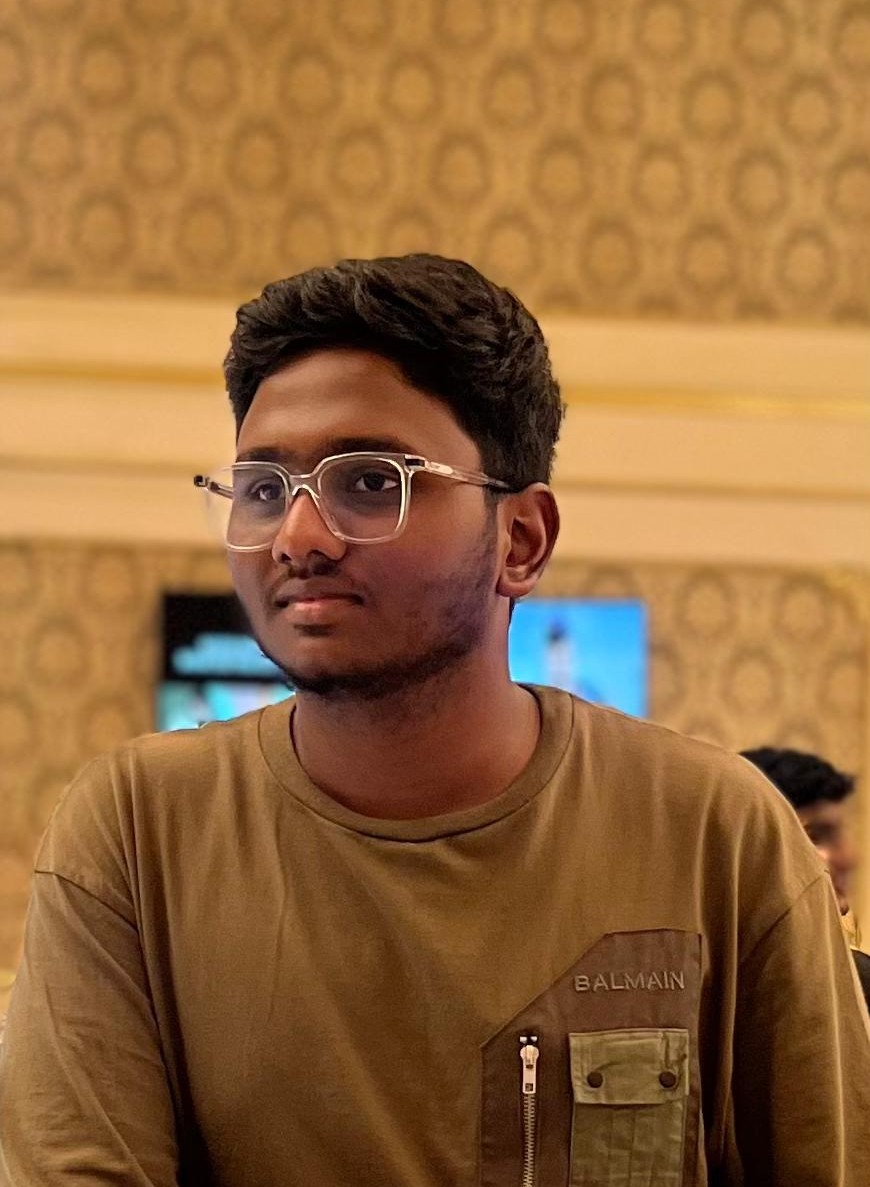Hi, I'm Chakradhar
AI/ML Engineer with strong foundations in machine learning, deep learning, cloud computing, and web development. Published researcher with experience in biometric systems, image analysis, and cloud-based applications.

AI/ML Engineer with strong foundations in machine learning, deep learning, cloud computing, and web development. Published researcher with experience in biometric systems, image analysis, and cloud-based applications.

I'm a passionate AI/ML Engineer and a recent graduate with a B.Tech in Computer Science, specializing in Cloud Computing, from SRM University, Chennai, with a CGPA of 9.64/10. My academic journey has been driven by curiosity and hands-on learning in the fields of artificial intelligence and machine learning.
In Fall 2025, I will be joining the University at Buffalo (SUNY Buffalo) to pursue my Master’s in Computer Science and Engineering, with a focus on the AI/ML track, where I aim to deepen my expertise and contribute to impactful research and development in intelligent systems.
Publications
CGPA
Major Projects
CEO, Excl Solutions Pvt. Ltd.
"Chakradhar demonstrated exceptional technical excellence and innovation during his AI internship with us. His work on machine learning techniques for TEM image analysis and particle detection significantly improved our pipeline accuracy and performance by up to 80%. His initiative in developing an AI-powered internal chatbot has been instrumental in helping our teams access project documents and datasets efficiently. I highly recommend Chakradhar for his technical skills, innovative thinking, and professional approach."
Enhanced biometric authentication system utilizing AES and RSA encryption, SHA-256 hashing, and blockchain technology to ensure data integrity and privacy.
Built a cloud-based healthcare platform enabling real-time ambulance tracking and secure patient data sharing using AES and SHA-256 encryption.
Engineered a CAPTCHA recognition system using CNNs and LSTMs, achieving 99.54% accuracy in handling complex CAPTCHA images.
Real-time underwater garbage detection system using advanced YOLO-based object detection and image segmentation models.
Developed a deep learning-based seq2seq model with attention to improve abstractive summarization. Leveraged LSTM layers to enhance contextual understanding in long text sequences. The model generates summaries that are more coherent and semantically rich. Demonstrated improved performance over traditional summarization techniques.
Proposed a hybrid deep learning model combining Convolutional Neural Networks (CNNs) and Long Short-Term Memory (LSTM) networks for accurate CAPTCHA recognition. The system effectively handles complex and distorted CAPTCHA images through preprocessing and robust spatial feature extraction. Leveraged CNNs for visual pattern recognition and LSTMs for sequential decoding. Achieved a peak accuracy of 99.54%, outperforming existing models in the field.
In this research, we tackle the urgent issue of real-time underwater garbage detection using state-of-the-art technologies. By integrating YOLO-based Object Detection and Image Segmentation Models, we've developed a robust system that can accurately identify and classify various types of underwater debris, even in challenging underwater environments.
This research on the transformative impact of Artificial Intelligence (AI) and Machine Learning (ML) in healthcare. Our paper delves into how predictive analytics, powered by ML algorithms, is revolutionizing patient outcomes, reducing costs, and optimizing resource management. Discover the applications, benefits, challenges, and future prospects of this cutting-edge technology in healthcare.
Developed a framework that combines NLP techniques with Sentence-BERT (SBERT) to enhance information retrieval from large online data sources. The system integrates morphological and semantic analysis to identify and extract key insights. Introduced a "summary summarization" module that condenses critical information into concise, meaningful outputs. The approach significantly improves the efficiency and accuracy of data comprehension in information-heavy environments.
This paper delves into the critical field of Named Entity Recognition (NER) in natural language processing, specifically focusing on journal articles. We provide an in-depth analysis of supervised learning approaches for NER, highlighting key evaluation metrics like precision, recall, and F1-score at both token and entity levels.
Proposed a novel method for tag-based image retrieval (TBIR) by integrating global and local visual features through hypergraph fusion. Constructed a hypergraph that captures relationships between image tags and features to improve retrieval accuracy. Incorporated pseudo-relevance feedback to refine results by identifying potentially relevant images. Experimental results demonstrate a significant boost in retrieval performance on platforms like Flickr.
Investigated the pathophysiology and clinical impact of Contrast-Induced Nephropathy (CIN) following cardiac interventions. Highlighted key risk factors including chronic kidney disease, diabetes, and advanced age. Evaluated both conventional preventive measures like hydration and emerging strategies such as controlled diuresis. Discussed the limited effectiveness of agents like N-acetylcysteine and emphasized evidence-based approaches to reduce CIN incidence.
Studied arsenic contamination trends in the Ganga-Brahmaputra river basin using hydrochemical analysis. Investigated how seasonal and temporal changes, particularly rainfall and groundwater flow, affect arsenic levels. Applied advanced analytical techniques to understand the mobilization and persistence of arsenic. Findings support the need for sustainable groundwater management to mitigate long-term environmental and public health risks.
I'm always open to discussing new opportunities, collaborations, or just having a chat about AI/ML and technology.
pchakradharreddy2004@gmail.com
+1 (716)292-2583
pchakradhar.com